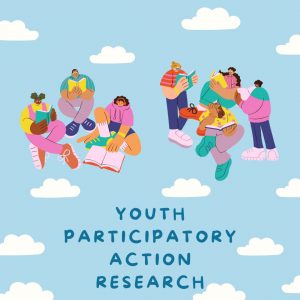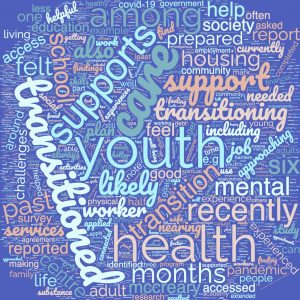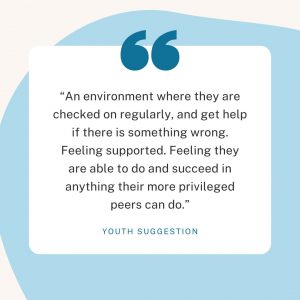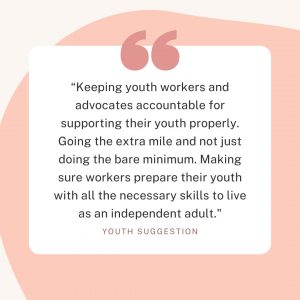
Megan Adams
Megan Adams is in her final semester of her undergraduate degree in Psychology at Capilano University. Megan has maintained at 3.8 GPA during her studies at Capilano University and has been recognized for making the Dean’s List for four consecutive semesters. Megan is planning to enter the workforce in either the non-profit or public service sector after graduation.
Personal Narrative
June 2022: A group of youth with experience in the government care system sit at desks unsure if they should introduce themselves to their neighbour, and nervous about the next eight months. This is the first day of seventh cohort the youth research academy at McCreary Centre Society. As the months pass these youth will connect with each other, learn research skills, and make recommendations about youth health issues in British Columbia. These youth, who vary from age 16-24, have decided that nothing about them will be done without them. This is youth participatory action research. This is my experience.
I have known very few other people that have had experience in the government care system in my life. It is an experience I have that is often unique to myself when I am in a group of my peers. This changed when I joined McCreary Centre Society’s Youth Research Academy (YRA). The YRA is a group of youth who have lived experience with the government care system. We look at issues facing youth in care as well as youth who are aging out of care and look to find solutions through research and using our own experiences. We help identify protective factors such as supportive adults, community connection, and sleep that help youth in other areas of their lives such as with their mental health. This experience has been more than just meeting other youth with government care experience. I have gained research skills, general work skills, public speaking skills and most importantly confidence in myself. As a student that is about to graduate from university this experience has also helped me reflect on what it is I want to do with my life and what might be possible.
McCreary Centre Society has a survey connected to youth aging out of government care that was created with input and feedback from youth with lived experience. Now, the findings are reviewed each year by youth with lived experience and their reflections are included in the following reports. During my time as part of the YRA, I have worked on projects for A Way Home Kamloops and the Surrey Poverty Reduction Coalition, and I have also had the opportunity to learn survey administration skills. This opportunity has left a lasting impact on me, and I have seen the benefits of youth participatory action research firsthand, but I find it interesting that I had never heard of it before this opportunity was presented to me. I wonder how many other youths are unaware of opportunities like this. I have become inspired to try to do more with the knowledge that I have, and although I do not know exactly what my future holds, I know that I want to pursue things that can have a lasting impact on my community.

This image conveys what youth participatory action research (YPAR) might look like. A group of youth with various life experiences and backgrounds coming together to work towards a common goal.
What is Youth Participatory Action Research?
Youth participatory action research (YPAR) gives youth the opportunity to positively impact issues effecting their health, development, and wellbeing. Lawson et al. (2015) encompass all of the important aspects of YPAR in this definition:
YPAR […] enfranchises youth as co-researchers. It also builds on their strengths in lieu of emphasizing their problem. Significantly, YPAR is structured to yield solutions (interventions) to significant problems that affect young people’s well-being, while at the same time providing them with the knowledge, skills, and abilities they need to thrive in life. (p. 68)
This definition shows a great understand of what is imperative for YPAR to be successful for both youth and the community.
Nothing about us without us
‘Nothing about us without us’ describes the thought that no policy change or research should be done without consultation of the group that said research or policy change will affect or is about. This is directly connected to the concept of YPAR and having youth involved in research that is being done about youth-related issues. Previously and continuously, decisions have been made without consultation of those who said decisions will affect. Policy makers such as government officials and social workers have implemented change based on their own recommendations or findings often without consideration of the needs and wants of youth. It makes sense that those with lived experience surrounding an issue would be truly knowledgeable about the area and have great insights about solutions or what the research should focus on. Although this phrase did not originate with YPAR it encompasses the concept well. Youth approach research with a different lens compared to adults, and this lens is their lived experiences.

This certificate signifies my experience of YPAR at McCreary Centre Society. It also recognizes my contributions to youth health in British Columbia. It represents more than just my graduation of the program though; it also represents everything that I have learnt and the skills that I will now carry with me through life.
Literature Review
Youth-led participatory action research can have long-term positive effects on youth who participate as well as on their health and well-being. Ozer (2017) explains that YPAR involves youth in the process and trains them to conduct research that is relevant to themselves. Ozer (2017) looks to further explain the effects of YPAR by looking at youth development and how YPAR has been shown to increase critical thinking, empowerment, and other skills. At its core YPAR is intended to support youth health through research as well as suggestions to policy changes (Ozer, 2017). Ozer (2017) captures the importance of YPAR “YPAR engages youth in analyzing and working to change the social, economic, and political conditions that shape their schools and communities, providing developmental opportunities” (p. 175).
The added value of youth participating in research is described by Burke & Hadley (2018) as the unique view that youth have of their community. Burke & Hadley (2018) convey the uniqueness of YPAR by describing it as “fundamentally concerned with providing various and often underrepresented voices with a chance to re-present that which gets seen and said about the research moment” (p. 219). This addition to the definition of YPAR speaks to the opportunity that participatory action research gives youth or other underrepresented groups to take part in a process that often excludes them.
As the population of young people increases it is important for there to be a focus on how young people can best be supported as they are developing (Ballonoff et al., 2021). This importance is amplified by the many challenges that young people face today. Ballonoff et al. (2021) describe that YPAR is not a new concept and right now there is an opportunity to use it very effectively by focusing on a youth’s developmental needs. To better understand the benefits of YPAR we can look at developmental science, specifically the effects of youth participating in YPAR at various developmental stages (Ballonoff et al., 2021).
The benefits of YPAR can be seen from age 10 to 14 in very young adolescents. At this age youth have “increased motivation in heartfelt goals” (Ballonoff et al., 2021, p. 32). This could mean that they can take more away from YPAR because at this age they can better grasp the goals and the potential effects of this kind of research. In very young adolescents some important developmental changes that might be occurring include the change of some neural networks, increased self-conscious feelings, as well as social changes (Ballonoff et al, 2021). YPAR can help youth with these changes by “provid[ing] meaningful opportunities for autonomy and fulfilling increased interest in, capacity for, and reward experienced from engaging in high-stakes social learning” (Ballonoff et al., 2021, p. 33). The evidence of these positive effects includes increased self-efficacy and confidence in some cases (Ballonoff et al., 2021).
Middle adolescent youth from age 15 to 19 see increased cognitive skills compared to very young adolescents. At this age there is more “cognitive control and emotion regulation, combined with increased sensitivity to social and affective motivational cues” (Ballonoff et al., 2021, p. 37). However, at this age there is often seen to be more risk-taking behaviours (Ballonoff et al., 2021). When looking at how youth might benefit from YPAR at this age it is important to consider the wider range of topics that might be appropriate for this age group. Also, being engaged with YPAR has been shown to help youth stay more engaged with school with increased achievements as well as attendance (Ballonoff et al., 2021). Other benefits for youth included “leadership opportunities, self-confidence, and career-building skills” (Ballonoff et al., 2021, p. 40)
Further benefits can be seen in older adolescents from age 20 to 24 as they begin to understand the position of adults in society better. This improved understanding manifests itself in identity development among older adolescents. Although there is very little evidence that looks specifically at the benefits of YPAR in this age group, some evidence points toward positive “self-expression, assertiveness, and feelings of liberation” (Ballonoff et al., 2021, p. 43). Ballonoff at al. (2021) call upon those who implement YPAR to focus on the developmental stages of youth to inform best practices. There is an opportunity for researchers to focus their efforts by identifying the changes occurring in a youth’s brain. By doing this, youth might see more benefit during their participation in YPAR.
There are both positives and challenges connected to youth participatory action research (YPAR) (Teixeira et al., 2021). Teixeira et al. (2021) describing the surge of youth-led activism in recent years and the call from organizations and universities for greater participation of youth in research. Further, Teixeira et al. (2021) speak to barriers such as adultism as well as other challenges including planning, time, and differing values. Adultism in this context refers to “a lack of pro-child social norms that includes negative attitudes about youth, laws that delegitimize youth, and youth internalizing these negative beliefs” (Teixeira et al., 2021, p. 143). Teixeira et al. (2021) describe the negative impact that this can have on YPAR because youth are given less opportunity to share, or their input is not taken as seriously. There is some concern that youth might be taken advantage of due to their vulnerable position and that there will be lack of care in their participation (Teixeira et al., 2021). Other potential issues including time often connected to the resources of funding a YPAR initiative. Some of these issues can be addressed by recognizing the discrimination that youth might face as well as other changes at a larger scale (Teixeira et al., 2021). The larger scale changes include addressing institutional values and priorities. The benefits of YPAR are greater than the challenges these issues might pose, which solidifies the importance of recognize the potential issues before they can affect the integrity of any YPAR initiatives.

This word cloud is a summary of McCreary Centre Society’s Youth Research Academy’s most recent report: Youth Transitioning Out of Care in BC: March 2022 Update. The largest word being “youth” conveys the significance of the report relating to the lives of youth in and from government care.
YPAR in Action
Formerly Incarcerated Teens
At a juvenile detention centre in New Mexico, youth were given the opportunity to share their thoughts and suggestions relating to the juvenile justice system. A group of youth that were either formerly incarcerated or allies, called the Leaders Organizing 2 Unite and Decriminalize (LOUD) worked together with adult facilitators to “research, gather data and present findings on juvenile justice reform” (Desai et al., 2021). The LOUD youth created a survey that was taken by 125 youth and also conducted focus groups within juvenile detention centres in New Mexico (Desai et al., 2021). LOUD was able to directly influence policy makers with their research. The specific ways in which LOUD influenced policy was through their concern about probation agreements that typically cause youth to stay on probation longer. LOUD youth advocated based on their own experiences for what youth needed (Desai et al, 2021). Another way in which LOUD youth influenced change was by sharing their personal experience in connection to incarceration with representatives from other states and countries (Desai et al, 2021). The Juvenile Detention Alternative Initiative was extremely interested in LOUD’s recommendations for anti-racist training amongst professionals within the juvenile detention centre system, especially because of the experiences of LOUD youth (Desai et al, 2021). Finally, the LOUD youth helped advocate for youth through partnerships and committees that allowed them to share their research findings and individual experiences (Desai et al, 2021).
Youth are the Solution in Memphis
Maria Oceja (2022) describes that increased conversation about violence began happening in Memphis when a local hero was murdered in 2021. She noticed the absence of youth within these conversations. However, Oceja describes practices being put in place in her own place of work that strive to engage youth with the largest issues facing their communities (2022). In 2019 a local youth council was formed that has since hosted events allowing other youth to share thoughts and recommendations regarding local issues (Oceja, 2022). The youth council has released reports which included recommendations that have since been implemented by their local school board (Oceja, 2022). This shows the impact that youth can potentially have on policy and that youth often know best about issues that are affecting them and their community.
Harm Reduction Led by Youth
Sedgemore & Canedo describe the realities of harm-reduction for youth in Vancouver and the often-negative experiences youth have in relation to this issue (2023). In conjunction with a team of university researchers, a youth health advisory council (YHAC) made up of youth with lived experience relating to “substance use and mental health concerns in the context of unstable housing and homelessness” was formed (Sedgemore & Canedo, 2023). Since this group was created in 2018, they have worked on research projects as well as a summit for youth (Sedgemore & Canedo, 2023). Based on their research as well as the lived experience of the youth on the YHAC a list of calls to action was created (Sedgemore & Canedo). This YPAR initiative is just another example of how youth can be involved in issues that matter to them as well as issues that affect them.
RYSE Youth Centre
In Richmond, California, the RYSE youth centre serves local youth and aims to continuously implement YPAR in their practices. “This involves ongoing listening and responsiveness to the priorities, needs, and interests of young people of color” (Villa et al., 2018, p. 598). At RYSE, youth engage with issues that they are facing as well as “determine action plans and recommendations that address the issue” (Villa et al., 2018, p. 598). Youth involved in YPAR at the RYSE Youth Centre have completed projects connected to gender and sexual based violence as well as coping strategies (Villa et al., 2018). The youth that conducted these research projects were given the opportunity to reflect on their experiences and describe the positive ways in which YPAR had impacted them (Villa et al., 2018). One youth stated that:
“Working at RYSE and conducting YPAR projects has made me realize that my community is hurting, and we are neglected the opportunity to heal properly and instead criminalized for the ways we choose to deal with our everyday struggles and traumas.” (Villa et al., 2018, p. 604).
This youth’s experience summarizes the similar sentiments that other youth have expressed. These youth and other youth that participate in YPAR see the value in what they are doing.
McCreary Centre Society – YRA Research and Reports
The most recent report put out by McCreary Centre Society’s Youth Research Academy is the Youth Transitioning Out of Care in BC: March 2022 Update. This report provides an updated look at the results from a study that focuses on the experiences of youth aging out of government care in BC (McCreary Centre Society’s Youth Research Academy [YRA], 2022). Throughout the report reflections from the 2021-2022 YRA members can be found, including insights about what data might mean and how youth can be better supported. The report also includes many impactful quotes directly from youth who took the survey about their experiences and suggestions they might have. Specific recommendations include the need to focus on youth having transition plans, as well as access to supports for mental health, housing, and education (YRA, 2022). The hope is that this report and future reports will be reviewed by service providers and people who work directly with youth aging out of care in BC so they can gain a better understanding of the experiences of these youth (YRA, 2022).
The executive director of McCreary Centre Society, Annie Smith described the YRA as an opportunity for “young people … to work on lots of different projects and [have] opportunities to … have input into lots of different things”. The YRA was originally funded through a grant from the Vancouver Foundation, however now the YRA gets funded by the projects that the youth work on, meaning it is very self-sustaining. Even as youth complete their time in the YRA they often stay connected to McCreary and the work that they do. McCreary Centre Society is a clear example of the success that organizations can have when they implement YPAR.


These two quotes are directly from youth who completed the McCreary Centre Society’s Transitioning Out of Care Study. Both quotes are describing suggestions of ways in which youth transitioning out of care could be better supported.
Conclusion
The benefits of YPAR have been made clear through evidence of positive impact the development of the youths as well as the promise of positive change in policy. As I reflect on my time in the YRA at McCreary Centre Society, I often find myself wondering about the long-term impact of the work I did. As we were given the opportunity to share some of our findings with service providers, I know that the research I helped with has the potential to impact policy. I can only hope that those service providers understand and value the experiences of youth as much as I do. As Annie Smith told me “the more things that…involve people from different groups that are impacted by the research, the better it’s going to be” and I have seen that to be true. Not just through reading about the impact of YPAR on youth but also my personal experience with it. Not just by thinking about the value youth can add but by helping create reports that include youth insights and feeling the impact of their words and of my words as well.
I hope that we see YPAR continue to be implement in research settings. The groundwork has been laid by organizations like McCreary Centre Society and the RYSE youth centre in California. These organizations have shown that successful YPAR is possible. Youth from these organizations have consistently described their experiences as positive and impactful in their lives. This type of research may seem intimidating to those that focus on the initial costs and resources needed to implement a YPAR program, but the benefits seen for youth and the community far outweigh any concerns. Youth have a lot of knowledge and experience that when shared in a research setting adds a level of value that cannot be fabrication. This is why YPAR is important, and this is why YPAR matters.
References
Ballonoff Suleiman, A., Ballard, P. J., Hoyt, L. T., & Ozer, E. J. (2021). Applying a developmental lens to youth-led participatory action research: A critical examination and integration of existing evidence. Youth & Society, 53(1), 26–53. doi:10.1177/0044118X19837871
Burke, K. J., & Hadley, H. L. (2018). “I’m Empowered by a Better Connection” : Youth Participatory Action Research and Critical Literacy. The High School Journal, 101(4), 217–235.
Desai, S. R. (2021, August 4). Formerly incarcerated teens share their research and ideas on how to improve the Juvenile Justice System. The Conversation. Retrieved from https://theconversation.com/formerly-incarcerated-teens-share-their-research-and-ideas-on-how-to-improve-the-juvenile-justice-system-160330
Hal A. Lawson, James Caringi, Loretta Pyles, Janine Jurkowski, & Christine Bozlak. (2015). Participatory Action Research. Oxford University Press.
McCreary Centre Society’s Youth Research Academy (2022). Youth transitioning out of care in BC: March 2022 update.
Oceja, M. (2022, May 26). Youth are not the problem: Let them be part of the solution. MLK50. Retrieved from https://mlk50.com/2022/05/26/youth-are-not-the-problem-let-them-be-part-of-the-solution/
Ozer, E. J. (2017). Youth-Led Participatory Action Research: Overview and Potential for Enhancing Adolescent Development. Child Development Perspectives, 11(3), 173–177. doi:10.1111/cdep.12228
Sedgemore, K.-O., & Canedo, J. (2023, February 10). We need harm reduction built for and led by Youth Who Use Drugs. Filter. Retrieved from https://filtermag.org/harm-reduction-youth/
Teixeira, S., Augsberger, A., Richards-Schuster, K., & Sprague Martinez, L. (2021). Participatory Research Approaches with Youth: Ethics, Engagement, and Meaningful Action. American Journal of Community Psychology, 68(1–2), 142–153. doi:10.1002/ajcp.12501
Villa, B., Wright, D., Ruiz, P., Boonnam, L., Lyman, L., Escobar, K., & Tilley, L. (2018). RYSE Youth Center: Youth Participatory Action Research. Journal of Family Violence, 33(8), 597–604.
